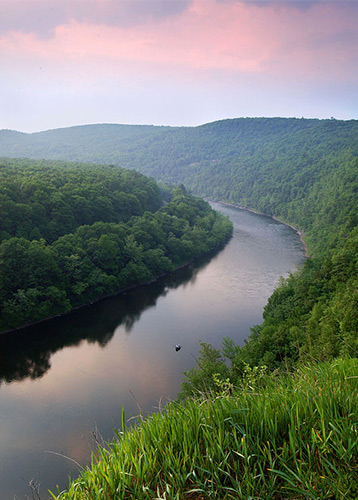National Environmental Policy Act (NEPA)
The National Environmental Policy Act (NEPA) is a critical law that empowers local communities to protect themselves and their environment from dangerous, rushed, or poorly planned federal projects.
Passed with an overwhelming bipartisan majority in Congress and signed into law by President Nixon on January 1, 1971, NEPA has offered nearly 50 years of protections for people and the environment facing the impacts of major government actions. NEPA has been a vital tool for communities within our watershed for many projects, including:
- Siting Hazardous waste facilities such as Elcon
- Construction of pipelines like PennEast through private lands or public parks
- Dredging or deepening of streams or rivers for navigation
For projects like these, NEPA mandates a review process with a series of broad opportunities for members of the public to participate. This process not only promotes better environmental accountability in government decision making but also gives the public a voice in major government actions. It is meant to ensure federal agencies and the public are fully informed of the environmental, economic, and health impacts before the government decides on any projects or legislation.
For example, NEPA:
- Allows local communities and citizens to participate in issues that will impact their health and environment
- Provides information and promotes awareness to communities for protecting their public health
- Promotes government accountability and transparency
- Can prevent poorly conceived projects thus saving taxpayer money
- Requires environmental review of major federal actions and for decisions to be made on sound scientific data and facts
- Ensures the protection of public parks and natural spaces for all to continue to enjoy
- Considers the protection of endangered species who inhabit the community and natural spaces
The Delaware Riverkeeper Network has experienced the importance of NEPA with many projects first hand, including the Susquehanna to Roseland 500kV Transmission Line Right-of-Way (ROW) and Special Use Permit application to the National Park Service (NPS) for an expanded ROW by PPL and PSE&G. The Project would affect three national park units, Delaware Water Gap, Appalachian Trail and Middle Delaware Scenic and Recreational River. The NEPA process was critically important by providing the robust, logical and predictable framework to which federal, state and local agencies, as well as the public, could fully and comprehensively evaluate alternative routes, total and cumulative impacts, including environmental, social, economic and other impacts, and mitigation opportunities. Specifically, the public had multiple opportunities to provide comment through the Scoping (Draft and Final), EIS (Draft and Final) and Record of Decision process. Over 5,000 comments were received. Also, as a result of the impacts to the Parks fully understood by the agencies and the public, a more accurate and justifiable mitigation plan, including site-specifics and timelines, was developed. Thanks to the NEPA process, the NPS was awarded a total of $66 million in mitigation fees when only $30 million was originally offered. Those funds were utilized to expand the size of the parks through open space purchases and the creation of habitat linkages with surrounding Game Lands, and to enhance ecological restoration and public outreach.
NEPA and Pipelines:
NEPA is meant to inform the communities and protect the environment they inhabit. In the fight against Federal Energy Regulatory Commission (FERC) regulated pipelines, compressors, and LNG export facilities, NEPA is one of the primary, and only, mechanisms communities can use to fully understand and vet the impacts of an infrastructure proposal. It is the public’s one avenue to learn about the full range of social and environmental impacts of a proposed pipeline before it’s approved—and to make the case that a project should not be approved by the powerful agency that is FERC. To learn more about the importance of NEPA in pipeline battles, see the webinars below.
Threats to NEPA:
Lately, legislators and politicians in Washington have tried to portray NEPA as a bad law claiming that it is barrier to economic growth and time consuming process. By doing this they hope to propose and pass legislation and policy changes that transform NEPA so that it will serve the needs of industry and developers before the people.
In 2018, the Trump administration proposed making huge changes to NEPA as part of the President’s infrastructure plans with the goal of “streamlining approvals”. This would be the first time NEPA guidance has been rewritten since 1978. On June 20, 2018, the White House Council on Environmental Quality (CEQ) announced an Advanced Notice of Proposed Rulemaking (ANPRM) and the Trump administration’s plans to re-examine longstanding NEPA regulations. In January 2020, CEQ issued the proposed rules overhauling the NEPA process. DRN signed onto a letter submitted on behalf of 331 conservation, health, and justice organizations and business urging CEQ to withdraw the proposed regulations. However, a final rule was issued in July 2020.
The final regulation could result in drastic changes to how we see NEPA enacted by legislative agencies. This includes agencies avoiding a full review of proposed projects, not accounting for cumulative impacts of projects, less opportunity for public involvement and input on projects, roll back on climate change considerations, and less protections for environmental justice and rust belt communities who are fighting an uphill battle to preserve the environment around them and avoid further citing of facilities in their area. Further it will help agencies such as FERC approve of projects faster with little consideration as to their future impacts.
The final rule is currently being challenged in several federal lawsuits.




